Be ready to take off your shoes when you travel to this part of the world. You never know when you are on holy ground, be it Buddhist, Hindu, Jain or Christian. Ironically, you don’t take off y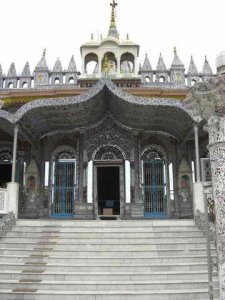 our shoes at airport security. But at some point, you’ve gotta join
our shoes at airport security. But at some point, you’ve gotta join  the barefooted contessas.
the barefooted contessas.
At Mother Theresa’s home, remove shoes before walking where she walked and kneeling before her tomb. It’s a hard habit to get used to so wear flipflops, sandals or something you don’t have to lean down to untie. Socks are good, and one German couple sluffed along in hospital shoe covers which they put over their socks. Sometimes the floors are ice cold stone, others boiling hot marble, sometimes disinfectant clean, others absolutely filthy. It’s hard not to wonder what we Americans might pick up with our weak immune systems. Someone is usually sweeping with a home-made broom of thin branches or grasses. But then, the other side is to have faith, that by doing the right thing in holy places, God protects.
It would also be good to bring ear plugs to India and Nepal. (My son-in-law sells earplug molds and I think I’ve discovered a whole new sales possibility.) Traffic is a free-for-all, with everyone laying on the horn for you or your vehicle to get out of the way, as if there was anyw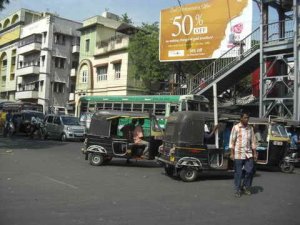 here to move to. (To boot, you are totally confused about when to cross the street since everything is backwards in these ex-British conclaves.) For some reason, I never heard or saw an emergency vehicle trying to get through, but then, with a thousand horns at different pitches, it was hard to hear the driver of my own vehicle speak. At least there are no boom boxers. They’d be deadened here.
here to move to. (To boot, you are totally confused about when to cross the street since everything is backwards in these ex-British conclaves.) For some reason, I never heard or saw an emergency vehicle trying to get through, but then, with a thousand horns at different pitches, it was hard to hear the driver of my own vehicle speak. At least there are no boom boxers. They’d be deadened here.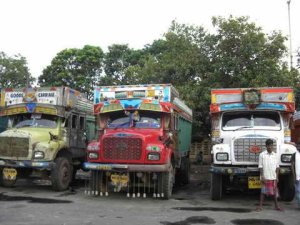 The worse horn blowers are the white tourist cars like mine. My Calcutta driver was awful and if someone refused to get out of his way, he’d literally run the guy (walking with a cane or on a skimpy bicycle) into the fence. I wanted to get out of the car in protest. The chauffeur in a white suit didn’t understand my English and I’d probably end up in the area where the next terrorist set off his bomb. But rickshaws have air horns, green and yellow taxis on three wheels called automatic rickshaws (how do they stay together?) abuse horns – hope you don’t slide out the doorless sides; yellow Ambassador taxis – millions of them -seem to think they own the road, like the buses loaded to the hilt with commuters. If there are fifty seats on the bus, there are one hundred passengers, mostly standing in a sweat in the middle. Trucks are allowed on many major streets and brush by at breath-neck speeds so you hope they don’t carry eggs. Military vehicles mastermind the single lane vias in border lands. I’ve never seen a police surveillance car or a traffic cop, except at one or two giant intersections programmed so it takes about 8 minutes for your side to be let loose to cross the road and continue. It’s a game of darts and strategy, who gets to that next free space first, who moves to the left first (drivers on the right side of the car) and who is a chicken. But until you have found refuge in your elaborate hotel, there is no silence in the cities, however large or small.
The worse horn blowers are the white tourist cars like mine. My Calcutta driver was awful and if someone refused to get out of his way, he’d literally run the guy (walking with a cane or on a skimpy bicycle) into the fence. I wanted to get out of the car in protest. The chauffeur in a white suit didn’t understand my English and I’d probably end up in the area where the next terrorist set off his bomb. But rickshaws have air horns, green and yellow taxis on three wheels called automatic rickshaws (how do they stay together?) abuse horns – hope you don’t slide out the doorless sides; yellow Ambassador taxis – millions of them -seem to think they own the road, like the buses loaded to the hilt with commuters. If there are fifty seats on the bus, there are one hundred passengers, mostly standing in a sweat in the middle. Trucks are allowed on many major streets and brush by at breath-neck speeds so you hope they don’t carry eggs. Military vehicles mastermind the single lane vias in border lands. I’ve never seen a police surveillance car or a traffic cop, except at one or two giant intersections programmed so it takes about 8 minutes for your side to be let loose to cross the road and continue. It’s a game of darts and strategy, who gets to that next free space first, who moves to the left first (drivers on the right side of the car) and who is a chicken. But until you have found refuge in your elaborate hotel, there is no silence in the cities, however large or small.
There are beggars and for a Christian, it’s a dilemma. If I had a box of sweets or a bag of rice, I’d feel good about patronizing the sad beggars. But money, no. For Hindus, handing a coin to a beggar means rewards elsewhere. So they make beggars insistent to tourists as well. Women holding armsful of children pick you out of a crowd and then follow you, right on your back or side mumbling something with a sad face, and when you get in the car they tap on the window to get your attention until finally, you are driven away. Obviously, I cannot solve the poverty programs in this nation, which is a lot different from the appearance of poverty in Nepal. Beggars don’t assault you in Nepal. Shop keepers do, practically grabbing you by the arm to come inside the store. The word “No” does not exist in Nepalese. So what do you do? A lot of back work. Don’t smile at the salesman in the street. I remember the same problem in Jerusalem a few years ago.
Greetings are constant when you enter hotels, restaurants, shops, museums. Last night, with a late arrival in Jaipur, I arrived at Rambagh Palace hotel (I have the maharani suite???? bigger than my house – it’s off season here) to be met with a cold face towel, a glass of fresh l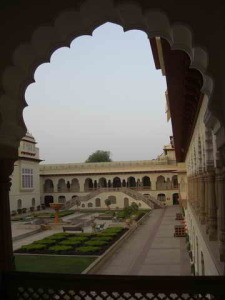 echee juice, and a fabulous lei of jasmine that I slept with because it smelled so good. Namaste is a savior when you don’t know the language. Put the palms of your hand together, bend slightly, and utter Namaste. In some parts of India, Julee is also used not only for hello, but goodbye and thank you. There is a courtesy and a modesty in most Nepalese and Indians. For one thing, women don’t fly down sidewalks or enter buildings with most of their skin showing, maybe a glimpse of a
echee juice, and a fabulous lei of jasmine that I slept with because it smelled so good. Namaste is a savior when you don’t know the language. Put the palms of your hand together, bend slightly, and utter Namaste. In some parts of India, Julee is also used not only for hello, but goodbye and thank you. There is a courtesy and a modesty in most Nepalese and Indians. For one thing, women don’t fly down sidewalks or enter buildings with most of their skin showing, maybe a glimpse of a 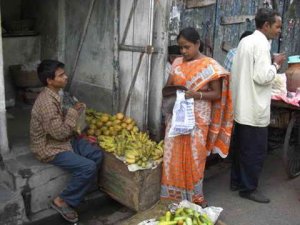 midrift, but no legs or chest. Never shorts, unless hikers, never bra straps dropping and bellybuttons displayed, not usually unless it’s a teenager who is trying to break out into the modern world. Most women and girls are beautifully wrapped in saris and versions of that. They also wear the pajama style pants (harem-ish) covered by a long colorful silk, gauze, or cotton knee length shirt. It is extremely comfortable, and the public doesn’t see something they should not be seeing.
midrift, but no legs or chest. Never shorts, unless hikers, never bra straps dropping and bellybuttons displayed, not usually unless it’s a teenager who is trying to break out into the modern world. Most women and girls are beautifully wrapped in saris and versions of that. They also wear the pajama style pants (harem-ish) covered by a long colorful silk, gauze, or cotton knee length shirt. It is extremely comfortable, and the public doesn’t see something they should not be seeing.
Beauty obsesses women in India. They see the most glamorous women on television and in Ballywood (which is in Bombay, a wild place) and they can probably imitate them, at least the young model-like women can. Only in Ladakh did women seem uninterested in elaborate dress. T he Tibetans wore dark wool long dresses to keep warm, but spruced up the look with a colored scarf thrown across the shoulders, turquoise and coral adornments, and some odd looking silk hats. Most women in India and in Nepal, who crave gold ornaments on them, go out of their way to make sure they don’t have gray hair. In the mountains, women and their daughters pass a day searching for gray hairs, which they pull out, so that even a woman in her sixties is white free. But they also, I’m told, have a problem with baldness. There comes a point when the hair doesn’t replace itself with any color.
he Tibetans wore dark wool long dresses to keep warm, but spruced up the look with a colored scarf thrown across the shoulders, turquoise and coral adornments, and some odd looking silk hats. Most women in India and in Nepal, who crave gold ornaments on them, go out of their way to make sure they don’t have gray hair. In the mountains, women and their daughters pass a day searching for gray hairs, which they pull out, so that even a woman in her sixties is white free. But they also, I’m told, have a problem with baldness. There comes a point when the hair doesn’t replace itself with any color.
Men tend to dress more like men at leisure. In Calcutta, overweight men with street lives wrap cloth like towels around their waist, wearing, I guess, nothing underneath and nothing on top. It’s a bit gross. They might throw on a long shirt if trying to impress or while unloading rice bags from a tall truck.. But there is a huge contingent of the business suit types, and the Nehru styles, and the white robed Ghandi style. In this heat, you want to get by wearing only what is cooling and comfortable. In many public places there are signs not to wash clothing in the pond, waterfall or river passing through. At the disparaging botanic garden in Calcutta, government owned huge plot of land where the world’s largest Banyan tree (250 years old, 1.8 kilometers diameter – it’s in the Guiness Book of World Records) can be seen. But everything else is a disaster, weed filled, and overgrown. In the tiny cactus pavilion, the barefoot caretaker, dressed only in a waist-wrapped blue and white check cloth, hung a line across one display so he might hang his wet clothes – which he must have just washed in the pond where the rare water lilies bloom, in spite of instructions at the gate, do not wash your clothing or utensils in the waters. But when you live on the street, you do what you have to do. So much of Calcutta lives on the street. It’s shocking to me, but probably not to them.
kilometers diameter – it’s in the Guiness Book of World Records) can be seen. But everything else is a disaster, weed filled, and overgrown. In the tiny cactus pavilion, the barefoot caretaker, dressed only in a waist-wrapped blue and white check cloth, hung a line across one display so he might hang his wet clothes – which he must have just washed in the pond where the rare water lilies bloom, in spite of instructions at the gate, do not wash your clothing or utensils in the waters. But when you live on the street, you do what you have to do. So much of Calcutta lives on the street. It’s shocking to me, but probably not to them.
I’ve already described a security check that one goes through at the airport. (At my hotel, each time you enter from the street in the car, a policemen passes the mirror thing under your car to make sure there is nothing untoward hanging there. India is never safe from terrorism. Too many issues on the table.) But on the other hand, you don’t have to take off your shoes, you don’t have to take out or announce you have a laptop, and you don’t have to dump the water bottle. You do have to wait. Few of my flights in India have departed on time. It’s impossible to understand the announcer who is speaking in English about your flight. Grab a coffee and some chocolate because that’s about all you’ll get and don’t forget to identify your bags after you pass through security.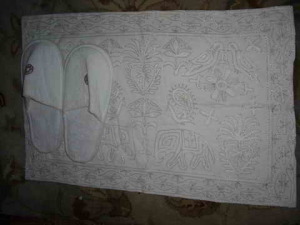
As peacocks shriek outside the windows, I will now slip into my cotton slippers, laid out for me on a silver and white bedside mat decorated with elephants, taste an Indian sweet treat a waiter brought for me, and pretend.
Photos: Shoes removed at Hindu temple; a rich Jain Temple, prepare to remove shoes on hot marble stairs; the automatic rickshaws; three mean trucks; Beggars line up for Hindu merchants handouts; The Rambagh Palace; A brightly dressed woman in the market; Another woman flower seller; the world’s largest banyan tree (only a slice of it); shoes for sleeping.

I think the custom of removing shoes is an excellent one.
I have an whole blog about removing shoes: Shoes Off at the Door, Please You might want to take a look.